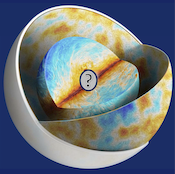Orateur
Description
Galaxy clusters are a powerful cosmological probe: they track the latest evolution of large scale structure and are therefore fundamental for testing the cosmological model in the recent Universe.
CMB experiments represent a great opportunity for cosmology with galaxy clusters: due to the inverse Compton scattering of CMB photons by the hot gas of clusters, they are signal-limited, full-sky (or at least large area) surveys of clusters.
To compare the observations of galaxy clusters with the theoretical prediction and thus constrain the cosmological parameters of the underlying model, a precise knowledge of clusters’ masses and redshift is required.
Scaling relations relating the mass with a given cluster observable (like the richness in optical wavelength, $Y_{SZ}$ in the mm-band or $Y_X$ in X-rays) are usually used to compute the mass of clusters.
We provide a new scaling relation using a large and representative sample of clusters from the Planck Early Sunyaev-Zeldovich catalogue that was observed in X-rays by Chandra, and compare it to the results of the Planck collaboration obtained from XMM-Newton observations.
We calibrate a new mass bias using weak-lensing data, obtain cosmological constraints from the Planck cosmological cluster sample and discuss the link between mass calibration and cosmological tensions.

